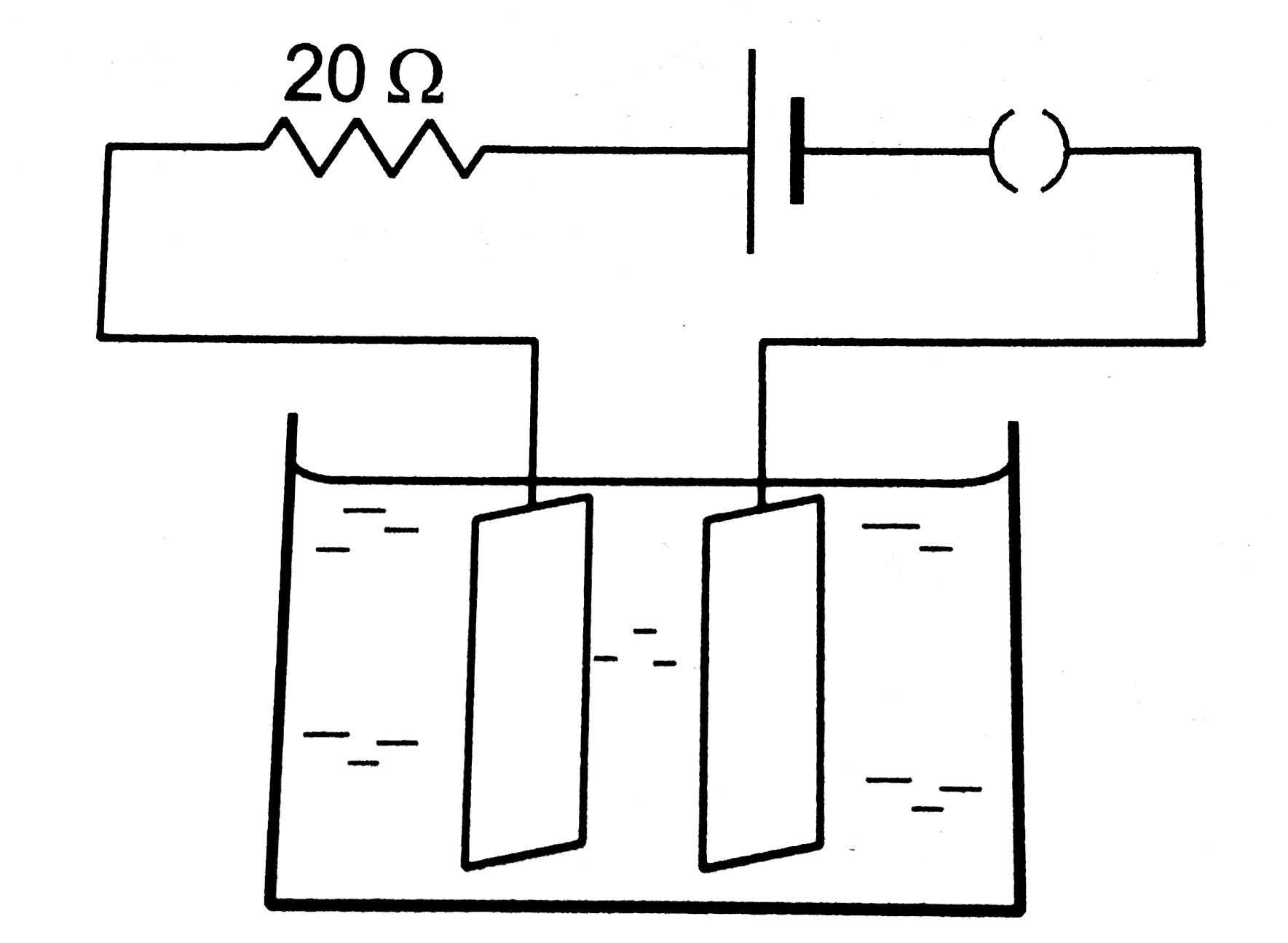Two voltameters, one having a solution of silver salt and the other of a trivalent-metal salt, are connected in series and a current of 2A is maintained for 1.50hours. It is found that 1.00g of the trivalent metal is deposited. (a) What is the atomic weight of the trivalent metal? (b) How much silver is deposited during this period?
Atomic weight of silver is 109.9gmol−1
The correct Answer is:A, B
To solve the problem step by step, we will break it down into two parts as requested: (a) finding the atomic weight of the trivalent metal, and (b) determining how much silver is deposited during the given time.
1. Identify Given Values:
- Current (I) = 2 A
- Time (t) = 1.5 hours = 1.5 × 3600 seconds = 5400 seconds
- Mass of trivalent metal deposited (m) = 1.00 g
2. Use Faraday's Law of Electrolysis:
m=z⋅I⋅t
where z is the electrochemical equivalent.
3. Calculate Electrochemical Equivalent (z):
Rearranging the formula gives:
z=mI⋅t
Substituting the known values:
z=1.00g2A⋅5400s=1.0010800≈0.0000926g/C
4. Determine Equivalent Weight:
The equivalent weight (E) of the trivalent metal can be calculated using:
E=z⋅Fn
where F (Faraday's constant) = 96500 C/mol and n (valency) = 3 (since it's trivalent).
E=0.0000926⋅965003≈2.97g/mol
5. Calculate Molar Mass (M):
The molar mass (M) is given by:
M=E⋅n=2.97⋅3≈8.91g/mol
6. Final Result for Atomic Weight:
The atomic weight of the trivalent metal is approximately 8.91 g/mol.
---
(b) Finding the Mass of Silver Deposited:
1. Identify the Electrochemical Equivalent of Silver (z2):
The atomic weight of silver (Ag) is given as 109.9 g/mol. Thus, the electrochemical equivalent of silver (z2) can be calculated as:
z2=109.996500≈0.00114g/C
2. Use the Relationship Between Masses:
From the relationship between the masses deposited:
m1m2=z1z2
where m1 is the mass of the trivalent metal and m2 is the mass of silver deposited.
3. Rearranging to Find m2:
m2=m1⋅z2z1
Substituting the values:
m2=1.00⋅0.001140.0000926≈12.3g
4. Final Result for Mass of Silver Deposited:
The mass of silver deposited during this period is approximately 12.3 g.
Summary of Results:
- (a) Atomic weight of the trivalent metal: 8.91 g/mol
- (b) Mass of silver deposited: 12.3 g
---
- Current (I) = 2 A
- Time (t) = 1.5 hours = 1.5 × 3600 seconds = 5400 seconds
- Mass of trivalent metal deposited (m) = 1.00 g
m=z⋅I⋅t
where z is the electrochemical equivalent.
Rearranging the formula gives:
z=mI⋅t
Substituting the known values:
z=1.00g2A⋅5400s=1.0010800≈0.0000926g/C
The equivalent weight (E) of the trivalent metal can be calculated using:
E=z⋅Fn
where F (Faraday's constant) = 96500 C/mol and n (valency) = 3 (since it's trivalent).
E=0.0000926⋅965003≈2.97g/mol
The molar mass (M) is given by:
M=E⋅n=2.97⋅3≈8.91g/mol
The atomic weight of the trivalent metal is approximately 8.91 g/mol.
The atomic weight of silver (Ag) is given as 109.9 g/mol. Thus, the electrochemical equivalent of silver (z2) can be calculated as:
z2=109.996500≈0.00114g/C
From the relationship between the masses deposited:
m1m2=z1z2
where m1 is the mass of the trivalent metal and m2 is the mass of silver deposited.
m2=m1⋅z2z1
Substituting the values:
m2=1.00⋅0.001140.0000926≈12.3g
The mass of silver deposited during this period is approximately 12.3 g.
- (a) Atomic weight of the trivalent metal: 8.91 g/mol
- (b) Mass of silver deposited: 12.3 g
Topper's Solved these Questions
- THERMAL AND CHEMICAL EFFECT OF ELECTRIC CURRENTBOOK - HC VERMA ENGLISHCHAPTER - THERMAL AND CHEMICAL EFFECT OF ELECTRIC CURRENTEXERCISE - Short Question
9 Videos
- THERMAL AND CHEMICAL EFFECT OF ELECTRIC CURRENTBOOK - HC VERMA ENGLISHCHAPTER - THERMAL AND CHEMICAL EFFECT OF ELECTRIC CURRENTEXERCISE - Objective 2
5 Videos
- THE SPECIAL THEORY OF RELATIVITYBOOK - HC VERMA ENGLISHCHAPTER - THE SPECIAL THEORY OF RELATIVITYEXERCISE - Short answer
2 Videos
- X-RaysBOOK - HC VERMA ENGLISHCHAPTER - X-RaysEXERCISE - Ques for Short Ans
10 Videos
Similar Questions
Figure, shows an electrolyte of AgCI through which a current is passed. It is observed that 2.68g of silver is deposited in 10 minutes on the cathode. Find the heat developed in the 20Ω resistor during this period. Atomic weight of silver is 107.9gmol−1. (Figure)

View SolutionTo dissolve 0.9 g metal, 100 mL of 1 N HCl is used. What is the equivalent weight of metal?
View Solution1.0 g of a metal oxide gave 0.2 g of metal. Calculate the equivalent weight of the metal.
View Solution1.0 g of metal nitrate gave 0.86 g of metal sulphate. Calculate the equivalent weight of metal.
View SolutionName the element
A trivalent metal used to make light tools.
View SolutionA current of 2.0A passed for 5 hours through a molten metal salt deposits 22.2 g of metal (At. Wt. =177). The oxidation state of the metal in the metal salt is
View SolutionFind the amount of silver liberated at cathode if 0.500A of current is passed through AgNO3 electrolyte for 1 hour. Atomic weight of silver s 107.9gmol−1
View SolutionThe equivalent weight of a metal is 9 and vapour density of its chloride is 59.25. The atomic weight of metal is :
View Solution1.0 g of metal nitrate gave 0.86 g of metal carbonate. Calculate the Equivalent weight of metal.
View Solution0⋅3605 g of a metal is deposited on the electrode by passing 1⋅2 amperes of current for 15 minutes through its salt solution. The atomic weight of the metal is 96. What is the valency of the metal ?
View Solution
